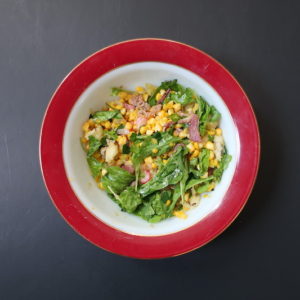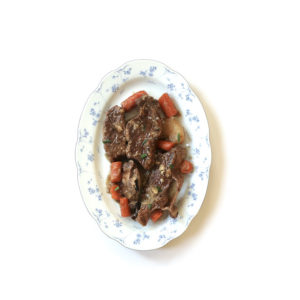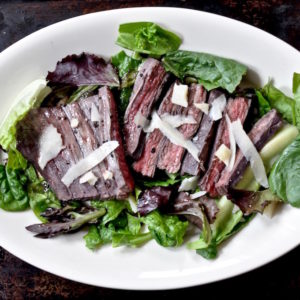Nearly Nicoise Salad
The recipe authenticity argument is a deep, dark hole we’re not going down today. I mean, if you want to go, I won’t stop you, but you’re going alone. Suffice to say the IK is not remotely qualified to call her salads “Nicoise.” She’s never visited Nice, for starters.
People who have spent time in Nice, trained as a chef (or both) get into volatile arguments about what constitutes a true Nicoise salad. Tuna, green beans, hard-boiled eggs, anchovies, tomatoes, plain boiled potatoes. A caper or two. An olive, Nicoise, of course.

Also there’s the annoying matter of hitting the “special character” table each and every time she types “Nicoise” to get that special squiggle under the c, making it look like this: ç. What’s that called again? A cedilla, according to the special character table.
About that tuna: some say it must be only the finest Spanish tinned ventresca, available in fancy gourmet shops at fancy gourmet prices. Use fresh, barely seared tuna, as I did, and be called names by esteemed chefs like Simon Hopkinson. After giving his exacting recipe for Salade Niçoise in The Good Cook, Hopkinson writes:
And, by the way, to use a slice of rare-grilled fresh tuna in this salad is a notion only to be entertained by the permanently bewildered.
It is true the IK suffers from permanent bewilderment, but this state is completely unrelated to the use of tuna, canned or otherwise.
This thing called the dinner salad is something of a departure for the IK. You know those people who claim they love salads for lunch or dinner? I am not one of them. When I hear “salad,” I think “plate of leaves,” and I confess: nothing sounds more unsatisfying to me. Alongside a meal, okay. For a meal? Just the meal? No way.

Plate of leaves or no, middle age means the ravening maw of adolescence vanishes, along with your rosy skin and shiny hair. The dinner salad may lack the appeal of steak frites, but if said salad has tasty additions like tuna, potatoes, and hard-boiled eggs, it becomes plausible.
(Ohmigod. The bulldozers are back. And they’ve brought their friends the jackhammers. WHY? WHY? What are they doing? And Why Are They Doing It In Front Of My House???)
Dinner salads are even more tolerable when accompanied by aïoli. Don’t freak out over making mayonnaise. Why are people so afraid of mayonnaise? If I, a person of permanents bewilderment and disability can manage mayonnaise, nearly anyone can. The only trick I’ve found is to start with room temperature egg yolks.

Egg yolks! You’re shrieking. Salmonella! I’m gonna die!
Yes, you are. But if you buy fresh, quality eggs, this will not be how.
If you aren’t a mayo eater or this just freaks you too far out, make a plain vinaigrette by mixing excellent Spanish wine vinegar with excellent olive oil. The rest of us will be sure to wipe our plate clean with fresh baguette, to save washing up.

Ingredients are flexible. Cook the tuna a little longer. Use chicken or tofu. Vegetables, at this time of year (the last day of August) are your choice.

Any leftovers are wonderful stuffed into a sandwich for a quick and dirty version of the pan bagnat. Don’t tell Simon. Heaven knows what he’ll call me.

Nearly Nicoise Salad
adapted from David Tanis’s A Platter Of Figs
Yield: 2-3 servings
amounts easily scaled upward
1 pound sear grade Ahi tuna
1-2 red bell peppers, seeded and cut into strips
5 large eggs (I used duck eggs)
4 ounces green beans, topped and tailed
12 ounces Yellow Finn or other small, waxy potatoes, scrubbed (approximately 5)
Mixed variety of heirloom tomatoes, 5-6. Slice just before serving
Small head butter lettuce (mine was 6 ounces)
Nicoise olives
To sear the tuna:
2 teaspoons fennel seeds
sea or kosher salt
pepper
olive oil
For the aïoli:
1 egg yolk, at room temperature
1 cup mild olive oil, at room temperature
garlic (to taste); I used one large clove
a little salt, ideally Kosher or Maldon, but use what you have
a little water, if needed
a little lemon juice, if needed
Baguette (optional)
Because I live in drought country, I use one pan of water to cook the eggs, green beans, and potatoes. Here’s how.
If you plan to make the aïoli, remove two eggs from the refrigerator. Set them aside so they can come to room temperature.
Bring a medium pot of water to a rolling boil. My pot is 4 quarts. When the water is boiling, lower 5 refrigerator cold eggs in. Count ten minutes from the time water returns to a boil. Remove eggs to an ice bath, crackling shells against sink or bowl to allow icewater to penetrate shells. This eases peeling.
Keep pot of water boiling.
While eggs cool, salt boiling water with a teaspoon of salt. Lower green beans into water. Cook 4-6 minutes, until al dente or cooked to your liking. Remove to a strainer with slotted spoon or spider.
Add potatoes to boiling water. They will need 12-16 minutes to cook through, depending on size.
While potatoes cook, peel and halve eggs. Put aside or, if you are not eating for a while, refrigerate.
Potatoes are ready when knife point pierces one easily. Drain. Whether or not you wish to peel is up to you. Halve them.
To sear the tuna, crush fennel seeds in a mortar. Sprinkle over tuna with salt and pepper. Get a cast iron pan or griddle hot. Add a very little olive oil. Sear tuna on both sides; how long is a question of personal taste; as you see from the photograph, I barely cooked our fish. You may wish to cook yours longer.
Slice tuna as you wish. At this point the dish can be refrigerated for several hours.
For the aïoli:
It is critical that all ingredients are at room temperature. Some people prefer to use half of a mild oil like safflower; this is a matter of personal preference. Taste as you go, and don’t use a bitter olive oil. Use a mild one.
Crush the garlic clove (s) in a mortar with the salt. You’ll only need about 1/4 teaspoon. Grind the garlic to a paste and scrape it into a wide, roomy bowl. I use a 4 quart Pyrex.
Crack an egg into your fingers and allow the white to fall through. Place yolk in the bowl with the garlic. Make sure the bowl is stable. If it wants to move around, sit it on a wet dishtowel.
Now take a whisk and lightly whisk the yolk until it lightens a bit. Pour a drop of oil in, whisking all the while. When it’s integrated into the yolk/garlic mixture, add a little more oil. Whisk until integrated. Keep going. The mixture will lighten considerably. When you’ve added about a quarter of the olive oil, you can start adding oil in larger amounts.
If mayonnaise breaks, crack that second egg, whisk the yolk in a clean bowl, and gradually add the broken mixture. You’ll have double the mayonnaise. There are worse things in life that lots of mayonnaise.
If the mayonnaise seizes up around the whisk–more likely–loosen by adding a little water.
You may not need or want all the olive oil. Taste, taste, taste. You may want a squeeze of lemon juice or salt.
Aïoli holds, covered and refrigerated, for about three days.
To serve: Arrange ingredients on platters or individual dishes, with baguette.
Any leftover fish should be eaten by the next day. It’s excellent in a sandwich.





